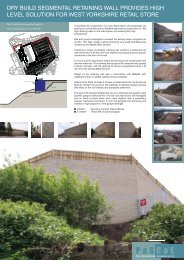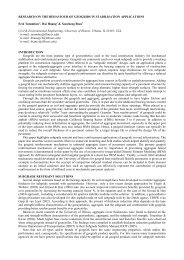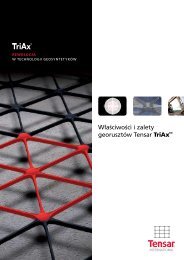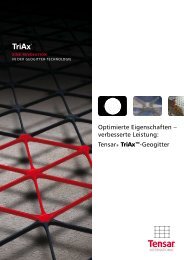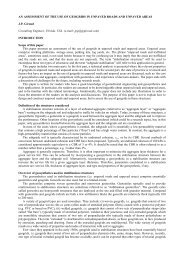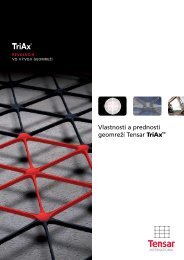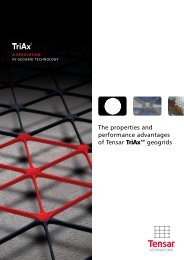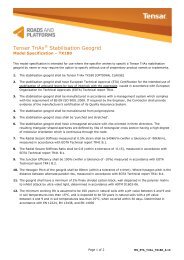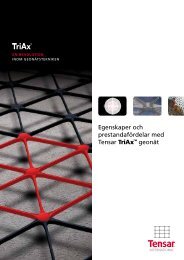Tensar TriAx Brochure
Tensar TriAx Brochure
Tensar TriAx Brochure
Create successful ePaper yourself
Turn your PDF publications into a flip-book with our unique Google optimized e-Paper software.
THE ADVANTAGES<br />
OF TRIAX GEOGRIDS COMPARED WITH BIAXIAL<br />
The unique <strong>TriAx</strong> structure incorporates several characteristics which combine to create an optimised<br />
structure that out-performs <strong>Tensar</strong> biaxial geogrids in trafficking applications. When combined<br />
with a suitable aggregate <strong>TriAx</strong> produces a mechanically stabilised layer with exceptional performance.<br />
LOAD DISTRIBUTION<br />
Load distribution is 3-dimensional in nature and acts radially at all levels in the aggregate.<br />
For a stabilised layer to be effective it must have the ability to distribute load through<br />
360 degrees. To ensure optimum performance, the geogrid reinforcement in a mechanically<br />
stabilised layer should have a high radial stiffness throughout the full 360 degrees.<br />
Load distribution<br />
acts radially.<br />
Junction integrity<br />
<strong>TriAx</strong> is produced from an extruded sheet of<br />
polypropylene. This is then punched with an<br />
array of holes and stretched to create the unique<br />
<strong>TriAx</strong> structure. This <strong>Tensar</strong> process, coupled with<br />
the design of the junctions, results in a product<br />
with high junction strength and stiffness.<br />
Junction efficiency<br />
Rigorous testing has been conducted in<br />
line with each of the three rib directions.<br />
In each direction tested, the <strong>TriAx</strong> geogrid was<br />
found to have high strength junctions and stiff<br />
ribs providing effective mechanical interlock of<br />
360°/0°<br />
aggregate particles into the aperture.<br />
Multi-directional properties<br />
315°<br />
360°/0°<br />
45°<br />
Biaxial geogrids have tensile stiffness<br />
315°<br />
45°<br />
predominantly in two directions. <strong>TriAx</strong><br />
geogrids have three principal directions of<br />
stiffness, which is further enhanced by their<br />
270°<br />
270°<br />
90°<br />
90°<br />
rigid triangular geometry. This produces a<br />
significantly different structure than any other<br />
geogrid and provides near-uniform stiffness<br />
through 360 degrees. A truly multi-directional<br />
product with near isotropic properties.<br />
The minimum radial stiffness for each product<br />
can be obtained from the relevant <strong>Tensar</strong><br />
product technical note.<br />
225°<br />
225°<br />
180°<br />
135°<br />
135°<br />
Minimum <strong>Tensar</strong> biaxial geogrid stiffness<br />
Minimum <strong>Tensar</strong> <strong>TriAx</strong><br />
<strong>TriAx</strong><br />
geogrid<br />
geogrid<br />
stiffness<br />
stiffness<br />
<strong>Tensar</strong> biaxial geogrid stiffness<br />
<strong>Tensar</strong> biaxial geogrid stiffness<br />
<strong>Tensar</strong> <strong>TriAx</strong> geogrid stiffness<br />
<strong>Tensar</strong> <strong>TriAx</strong> geogrid stiffness<br />
The polar diagram shows the shape of tensile<br />
stiffness plots for <strong>Tensar</strong> biaxial and <strong>TriAx</strong> geogrids<br />
manufactured from the same sheet thickness, with<br />
<strong>TriAx</strong> exhibiting near-isotropic properties.<br />
Node structure providing high junction efficiency.<br />
4



